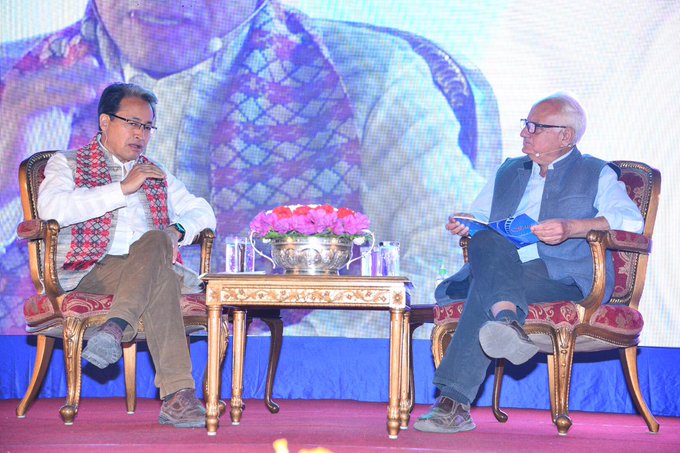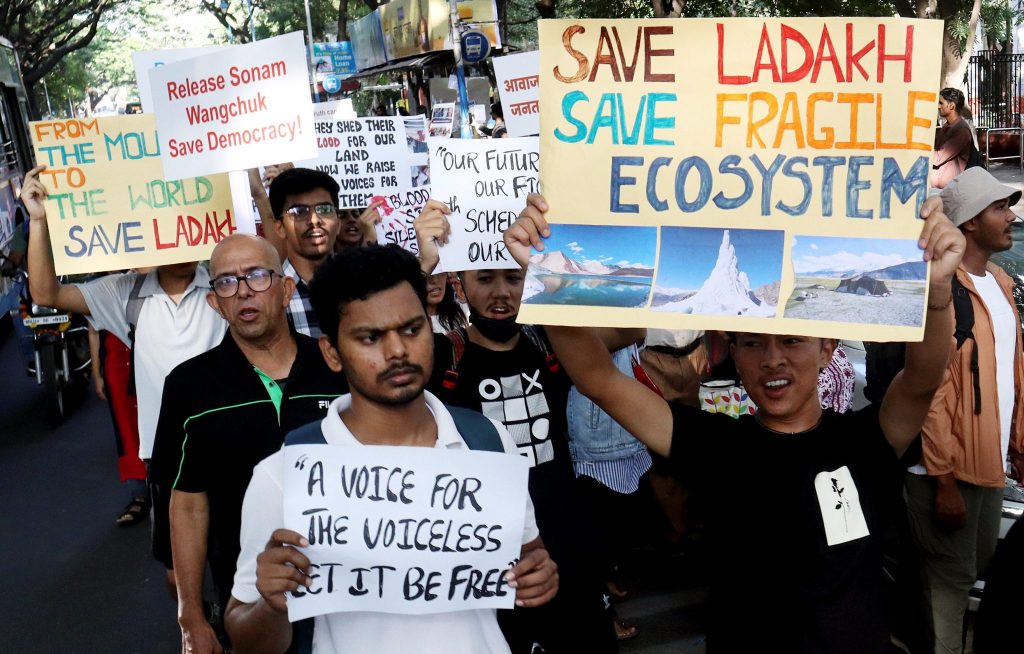From The Wire (Oct 9, 2025)
Nearly four decades of following the work of Ladakh’s well-known educator and activist leaves no doubt that he is a force for good for India and the subcontinent.

Seen from a neighbouring Himalayan capital, the persecution of Ladakh’s Sonam Wangchuk by the Indian government, his arrest and incarceration in faraway Jodhpur, provides one more unwelcome indication of democracy’s decline in India. For decades in the post-Independence era, this was the country that held high the panos of civil and political liberties, what adjacent societies aspired for.
The unfolding saga points to two areas of concern regarding the Narendra Modi government’s policies and agenda. First, its attempt to centralise governance over a population as large and diverse as India’s; second, its wants to go at it alone when the times demand reaching out to neighbouring countries on urgencies as diverse as economic rationalisation and growth, militarisation, sustainable peace, nuclear disarmament, climate crisis and sharing of river waters.
Wangchuk’s detention under India’s National Security Act is all the more incongruous given his enthusiastic support when the Modi government bifurcated the state of Jammu and Kashmir in 2019, with Ladakh emerging as a Union Territory.
One could have predicted that providing local governance for Ladakh was not part of the Bharatiya Janata Party-Rashtriya Swayamsevak Sangh regime’s centralising push. While proactive federalism is the only solution for a land as vast and diverse as India (the same also holds true for Pakistan), Modi’s stance has been against both provincialisation and localisation.
Global problem, local answer
Over four decades, as an environmentalist, educator and innovator, Sonam Wangchuk sought local answers to good governance, global warming, housing, migration, irrigation and income generation.
His conclusion was that lasting transformation requires representational politics and – coming from a Himalayan borderland in the time of climate crisis – cross-border collaborations.
He sought to take his message beyond national borders, to Kathmandu, Dhaka, Islamabad and farther afield. A citizen of the High Himalaya – ‘Himali’ being the nomenclature evolved in Nepal for the highlander demography extending from Baltistan to Arunachal – Wangchuk understands that our mountain ecology is a bellwether for the transforming world climate. As the ‘third pole’, because it is populated unlike the other two nodes, the Himalaya is in a position to alert the world.
While sparsely populated, the Himalaya-Hindu Kush provides life-sustaining water to more than two billion people of South and East/Southeast Asia. This region is in crisis on multiple fronts, from out-migration, receding glaciers, loss of groundwater, dilution of language and culture, poor government school education, absence of representational power in the respective national polities, and so on. Wangchuk emerged as a voice of reason and activism in each of these areas.
While indulging him for a while, the New Delhi authorities ultimately decided they were not amused by his Ladakhi activism, and even less so by his internationalism. Confronted by the Union government’s unwillingness to implement the Sixth Schedule of India’s Constitution as promised, he embarked on the Gandhian path of protest, with peace marches to New Delhi and hunger fasts under the open Ladakhi sky.
Personally speaking
I speak of Sonam Wangchuk with conviction, having followed his activism since the late 1980s. When Himal magazine was started (as a Himalayan periodical that evolved into today’s Southasian avatar), we covered the establishment of the Students’ Educational and Cultural Movement of Ladakh (SECMOL), founded in 1988 by young Ladakhis led by Wangchuk to reform local education. At the time, fully 95% of Ladakh’s children were failing 10th grade examinations and school textbooks had little reference to local cultures and realities.
Himal visited SECMOL again in its September 2007 issue, with an article titled ‘Education reform, interrupted’. It described how, after having transformed Ladakh’s educational system, the grassroots reform movement was “struggling against vendettas spearheaded by those in the bureaucracy.”

In later conversations, Wangchuk emphasised the importance of reforming government schools not only in Ladakh and India, but all over South Asia. This was important for the sake of dignified livelihoods, but also to prevent social unrest that could derail socio-economic progress. It was his conviction that alert parents and local communities provided the pathway to force governments to deliver quality school education.
Over the course of the 2000’s, Wangchuk came to Nepal to help construct climate-friendly schools and homes based on mud architecture, which was his engineering speciality. He learnt the Nepali language while pioneering an initiative against cement and concrete, marrying traditional architecture with modern-day innovations.
He visited Nepal again in the aftermath of the April 2015 earthquake, to deliver support to the Helambu region. At the Institute of Engineering in the Valley, Wangchuk inspected the lightweight demonstration structure he had helped construct a decade earlier using bamboo and ferrocement. He reported: “This earth building was in very good condition with no effects of the earthquake that I could see.”
Looking beyond schools and textbooks, understanding that higher education too must be relevant to specific regions and economies, with his spouse Gitanjali J. Angmo (from Odisha), Wangchuk started the Himalayan Institute of Alternatives, Ladakh (HIAL). It began offering courses in appropriate architecture, energy studies and responsible tourism.
Ladakh-Delhi dissonance
Wangchuk believed – mistakenly, as it turned out – that the eclipse of Article 370 of the Indian Constitution followed by bifurcation of Jammu and Kashmir would lead to genuine self-governance for the people of Kargil and Ladakh under the Sixth Schedule or statehood. He had not taken into account the cognitive distance between Leh and New Delhi, as well as the paranoia of the state apparatus and ‘think-tankers’ that regard the Himalayan region mainly through the lens of geo-strategic vulnerability.
This syndrome, which has its origins in the 1960 debacle with China, has hampered the practice of politics and governance across India’s Himalayan region, and also impacts Nepal and Bhutan.
With the Union government intransigent on Ladakhi demands, Wangchuk went on an extended hunger strike in the Spring of 2024, a ‘climate fast’ to draw attention to global warming and local rights over natural resources. Concerned for his life, ten of us ‘concerned individuals from the Himalayan region’ put out a joint statement on March 24 – the 21st day of his fast.
We applauded Wangchuk’s “steadfast voice for social justice and ecological sanity” and supported his demand for political rights for Ladakh and nature-friendly approaches to development in the Himalaya and elsewhere. The ‘Himalayan’ signatories were: Chandi Prasad Bhatt, Bharat Bhushan, Kanak Mani Dixit, Ramachandra Guha, Sanjoy Hazarika, Pervez Hoodbhoy, NayanTara Gurung Kakshapati, Mrinal Pandey, Shekhar Pathak and Siddiq Wahid.
Indian embassy event
That Wangchuk was also held dear by sensible people in the Indian state mechanism is evident from his being hosted by the Indian Embassy in Kathmandu on March 28, 2021 for a discussion on ‘Re-imagining Education, Innovation and Sustainability in the Himalayas’.
I was invited by the Embassy to be ‘in conversation’ with him before a heavyweight audience. We ranged far and wide (partly in Nepali) as Wangchuk expounded on school and higher education, architecture, solar heating, earthquake-resistant engineering and local answers to global challenges such as the climate crisis.
In conversation, Wangchuk said: “From Baltistan to Arunachal, we are showered by abundant sunshine, so we must harness solar power for progress.” The people of the Himalaya had something to share with the world in how they preserved cultural diversity and crop diversity. Out-migration from the hills could be halted only through creation of sustainable local economies. The climate crisis could not be tackled in the absence of transboundary cooperation, and the Himalayan people were the first to understand this, he said, “because we are on the frontline of the onslaught.” He added: “The five-year formula of electoral politics does not help in the fight against climate change.”
When it comes to government policies in various fields, Wangchuk said if the people at large had their priorities right, the government was bound to follow. “Take the case of Ladakh, if the people continue to insist on subsidies for kerosene and rice rather than more sustainable choices, then kerosene and rice is what the government will deliver.” Regarding schools, he was clear: “If those who have a stake also have a say, meaning parents and communities, then the quality of teaching and learning is sure to improve.”
‘Breathe Pakistan’
On 6-7 February 2025 in Islamabad, the Dawn national newspaper hosted an international climate change conference, though titled ‘Breathe Pakistan’. I was present together with peers from Dhaka, New Delhi and elsewhere, including Wangchuk from Leh.
My own presentation was on the need for India and Pakistan, in particular, to collaborate against the Indus-Ganga smog, reduced groundwater and river flows, and the melting not just of snows, but the permafrost that holds billions of tons of debris in its grip across the Himalayan chain.
Known the world over for his innovation in tackling water scarcity in the high desert through ‘ice towers’ created during the winters, Wangchuk was part of the panel ‘Glacial Melt: A Sustainable Strategy for the Water Towers of South Asia’.
If there is one important global warming topic for South Asian societies besides the rising sea level, it is the receding snow and ice. The disasters that come, including extreme weather events, will not distinguish between Nepal, India, Pakistan, Bhutan or Bangladesh. I recall Wangchuk’s praise of Modi’s leadership on climate change, for taking many initiatives including ‘Mission Life’ urging people to live simpler lives.
The fulsome applause was no protection when the New Delhi regime decided to go after Wangchuk, as a voice from a border region who dared to defy the high and mighty of Raisina Hill. After the violence of September 26, when the BJP office in Leh was torched and police firing killed four Ladakhi protestors, matters came to a head. The authorities decided to make an example of Wangchuk, rescinding the foreign funding privileges of SECMOL and HAIL to begin with.
For good measure, the authorities booked Wangchuk under the National Security Act for anti-national activities, with Ladakh’s Director General of Police making much of the fact that he had visited Bangladesh and Pakistan, and “held interactions with Islamabad-based officials”. The implication being that he had made common cause with the enemy. “Sonam Wangchuk has had a history of instigating. He has referred to the Arab Spring, Nepal and Bangladesh,” the DGP said.
And so we have arrived at a point where citizens are not to travel across borders even to discuss a crisis as existential for South Asian and global humanity as the climate emergency. Wangchuk’s incarceration is further indication that the largest and most powerful country of South Asia is on an unsustainable undemocratic path. And yet, Ladakh shows the way.
Kanak Mani Dixit is founding editor of Himal, the Himalayan periodical that transformed into a Southasian publication.